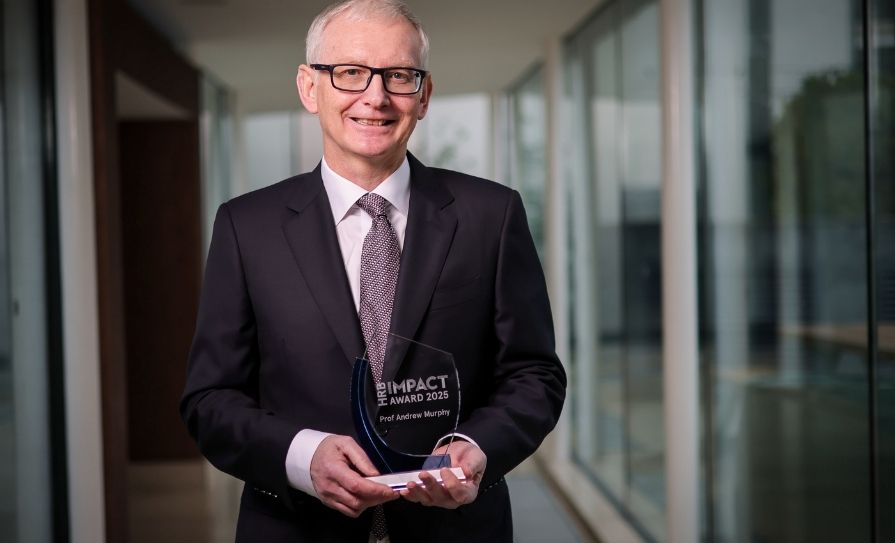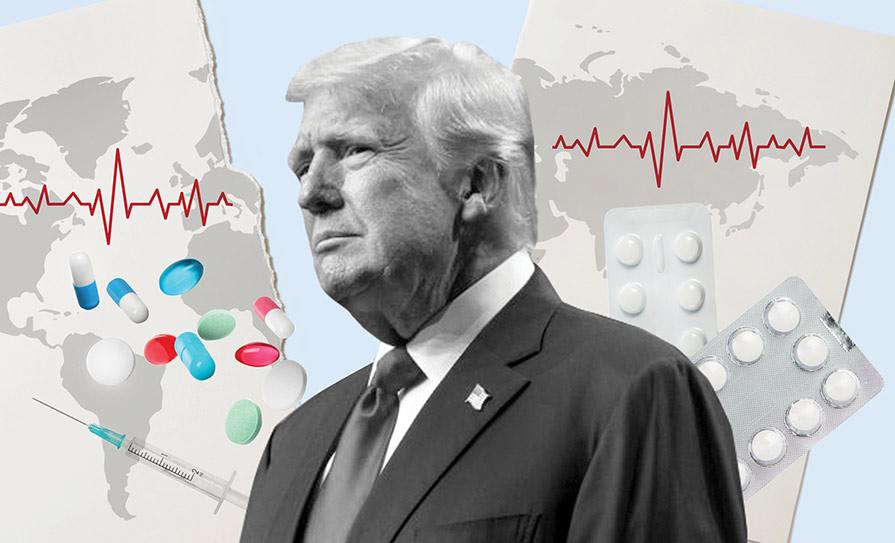The Covid-19 pandemic is far from over and the protection of healthcare workers will remain an issue of concern for some time to come. Catherine Reilly reports on continuing misgivings from some specialists about the control measures deployed in healthcare.
The Dean of the Faculty of Occupational Medicine, RCPI, Dr Robert Ryan, has confirmed to the Medical Independent (MI) that “concerns” have been expressed to the Faculty by some “senior” occupational medicine specialists about Covid-19 control measures to mitigate infection risk and protect staff in healthcare settings, as outlined in HSE national guidance.
“In response to some concerns from some senior occupational health physicians about the issue of mitigation measures, I am at the moment in a process of dialogue with other stakeholders… so that this concern is given sufficient exploration. We work in a collaborative environment; we work with public health; we work with infectious diseases; we work with hospital management; we work with our colleagues,” according to Dr Ryan, Specialist in Occupational Medicine and Managing Partner at Medmark (Dr Ryan does not personally work in the HSE. Medmark provides services to HSE/public healthcare organisations).
In regard to protecting healthcare staff from workplace-acquired infection, Dr Ryan said his observation was that the HSE had instigated a wide range of control measures. “I think in any scenario such as this, more or better could always have been done, but that would be true in any set of circumstances. It seemed to me they reorganised the workplace, the working practices, they brought in the appropriate mitigation measures, provided the necessary equipment in terms of personal protection, to try and protect healthcare workers.”
According to Dr Ryan, it was appropriate that the guidance remained under constant challenge and scrutiny. “I think that conversation is an ongoing one, I don’t think it’s a static conversation, and the guidance has evolved over time and in particular with the arrival of the more transmissible variants.” (see panel).
The Covid-19 pandemic represents the greatest occupational health challenge of modern times with healthcare workers facing a disproportionate risk of infection compared with the general population.
Unfortunately, the pandemic is far from over and the protection of healthcare workers will remain a live and dynamic issue for the foreseeable future, particularly in the context of potential new variants that may be less susceptible to vaccines. The proportion of healthcare worker cases has declined substantially in comparison with 2020, but the virus continues to pose a significant risk to the health and wellbeing of staff, as well as threatening service delivery. In early November, up to 3,500 health staff were reportedly absent from work due to Covid-19.
According to figures from the Health Protection Surveillance Centre (HPSC), between 12 September and 9 October 2021 there were 1,417 reported cases in healthcare workers, representing 3.8 per cent of the total cases in the population. A small proportion of the healthcare worker cases were confirmed as “likely” workplace-acquired. During much of 2020 about one-third of cases in the population were in healthcare workers.
Since a notification requirement on employers was effected on 24 November 2020, under the biological agents regulations, the Health and Safety Authority (HSA) has received 724 reports covering 1,211 occupational cases of Covid-19 in employees in health and social care (as of 29 October).
“The Authority is also aware of 17 reports of healthcare workers who have reportedly died with Covid-19,” stated a HSA spokesperson. “The Authority have commenced investigations into these reports to ascertain the relevant facts.”
Six claims have been made against the HSE by healthcare workers due to illness arising from Covid-19 infection allegedly acquired in the workplace, according to the State Claims Agency. One claim has been made regarding the death of a healthcare worker.
In late October, the Irish Nurses and Midwives Organisation (INMO) stated that it had requested the HSA to “reinforce the risk mitigation requirements” of the biological agents directive, which was transposed into Irish law. This Directive directs employers to ensure that all necessary measures, including vaccines, are made available to afford maximum protections to those exposed to Covid-19.
Speaking to MI, Mr Kevin Figgis, Divisional Organiser, SIPTU Health, underlined that the HSE must fulfil its duties “as an employer and not just as a health provider”.
Health and safety
One of the principal duties and responsibilities of occupational health physicians in the HSE is advising management on occupational health issues including the operation of health and safety law. Under legal provisions, employers are required to conduct risk assessments where employees are at risk of exposure to a biological agent (such as SARS-CoV-2). Where it is not technically possible to prevent exposure, measures must be applied to ensure that “as far as technically practicable” the exposure level is reduced to “as low a level as necessary in order to adequately protect the health and safety of the employees concerned”.
Throughout the pandemic, MI understands that some occupational medicine specialists have argued for additional control measures in healthcare including a higher standard of respiratory protection and greater emphasis on ventilation, as examples. This advice has been based on scientific data on SARS-CoV-2 (and other viral transmission), uncertainties in the face of a novel pathogen, and health and safety law.
However, they say their advice was not reflected in national guidance and may not be adopted by managers.
It was a “perfect storm in occupational health”, stated a specialist, who said they were tasked with implementing operational policies and then faced with, in their view, “the failure of those operational policies” in the form of long Covid, moral injury and post-traumatic stress, etc. At State level, “we are trailing behind [the virus] continuously” with community transmission seeping into healthcare settings.
I think in any scenario
such as this, more or
better could always
have been done, but
that would be true in
any set of circumstances
While mask policy is only one element of the hierarchy of control measures, it is a key matter on which some occupational medicine specialists have advised a different approach – namely, much more widespread use of respirator masks in healthcare. In early 2021, the HSE advised that respirator masks (FFP2) should be available for healthcare workers when in contact with possible or confirmed Covid-19 cases and contacts. The change came on foot of the emergence of the Alpha variant and pressure from the INMO. In advance of this update, use of surgical masks (for close patient care) was deemed appropriate with the exception of a defined set of ‘aerosol generating procedures’ where respirator masks were advised.
It was September 2020 before guidance also required healthcare workers to wear a surgical mask when in “busy public areas of healthcare facilities, even if they do not expect to be within a distance of 2m of another person for 15 minutes or more”.
However, the level of protection afforded by surgical masks has been described by Prof Raymond Agius, a UK-based occupational medicine specialist, as akin to ‘wearing slippers on a building site’. In an article in Occupational Medicine in April 2020, and on social media, Prof Agius has also drawn attention to research published by the UK’s Health and Safety Executive in 2008 (‘Evaluating the protection afforded by surgical masks against influenza bioaerosols’), which focussed on the effectiveness of surgical masks against a range of airborne particles.
Using separate tests to measure levels of inert particles and live aerosolised influenza virus, the findings showed that surgical masks provided around a six-fold reduction in exposure. Live viruses could be detected in the air behind all surgical masks tested. By contrast, properly fitted respirators could provide at least a 100-fold reduction.
During the pandemic, research has also emerged in support of the higher protection afforded by respirator versus surgical masks (eg, a paper released in June from Addenbrooke’s Hospital in Cambridge, demonstrating far higher protection afforded by FFP3 versus surgical masks for staff on Covid-19 wards).
In a statement to MI in November 2020, the HSE outlined that infection prevention and control (IPC) guidance was based on an assessment that SARS-CoV-2 was “in most circumstances” a contact- and droplet-transmitted infection and “the evidence that surgical masks offer equivalent protection to respirator masks in this context”.
In recent months, the INMO has called on the HSE to instigate a number of additional measures, including urgent access to the booster vaccine (since approved by the Department of Health), that FFP3 respirator masks be a mandatory requirement for healthcare workers in direct contact for extended periods with Covid confirmed patients; confirmation that the requirements in the code of practice for biological agents would be adhered to; and serial testing in health facilities in high-risk areas.
However, MI understands that HSE Antimicrobial Resistance and Infection Control (AMRIC), led by Consultant Microbiologist Prof Martin Cormican, has robustly defended existing IPC/personal protective equipment (PPE) guidance following criticism from healthcare unions.
The HSE AMRIC has pointed out that, under the guidance, respirator masks (FFP2) should already be available to healthcare staff likely to be in contact with patients with Covid-19 and this is not restricted in terms of duration of contact. Furthermore, in practice, there was “no evidence” of any difference in protection against infection between FFP2 and FFP3 masks. HSE AMRIC has also maintained that there is access to testing for staff who are symptomatic and that the HSE tests asymptomatic staff where a public health policy or local risk assessment supports such a move. Moreover, there are pilots of serial testing underway in some settings.
Ms Orla Hegarty, Assistant Professor, School of Architecture, University College Dublin, does not consider that current national policy on ventilation and masking in healthcare settings is adequate.
According to Ms Hegarty, it was “clear from the research” that basic plug-in HEPA filtration in a patient’s room and staff respirator masking in patient and non-patient areas substantially cuts transmission risk.
“So if that was done everywhere, we would not have issues in hospitals and care homes.” She said while there was “some information” on ventilation in HSE/HPSC guidance for healthcare settings, it was not sufficiently specific.
Ms Hegarty added: “If you are in a hospital building as a worker, you have to assume that, firstly, you need a respirator mask for airborne precautions, not a surgical mask, and secondly, staff need to be wearing that everywhere in a hospital, not just within two metres of patients. Because it is the same air throughout the hospital. The advice and policy have been unclear on that, and inevitably we are now seeing outbreaks in hospitals, infection of people in hospital for other [conditions], infection of healthcare workers and nursing home outbreaks.”
Ms Hegarty said health and safety law was “very clear” that it was the employer’s responsibility to do a risk assessment in the workplace, assess every risk and take appropriate precautions.
Recalling the experience of the construction sector in the 1990s, Ms Hegarty said there was very weak health and safety in the sector and annual fatalities. However, with advances in health and safety law, the standards in construction greatly improved. Healthcare operates as a workplace under the same regulations, she said.
“The policy for masking in hospitals seems to be ‘ask for a better mask if you think you need one’. In fact, speaking and breathing generates more aerosols than many aerosol generating procedures. That wouldn’t wash in construction, workers don’t decide what PPE they wear on site. Hospitals need to train staff and enforce the use of appropriate PPE.
“I can understand right at the start of the pandemic there was an issue with supplies and procurement, but there is no issue with supply of proper masks, production is widely available.”
Ms Hegarty said that, under current guidance, many healthcare staff may be reassured to remove their masks in empty toilets, lifts, and staff rooms, but she cautioned that these settings can represent a high risk for transmission as airborne virus particles can linger for hours in certain conditions.
While the legacies of under-engineered and over-occupied healthcare settings may have played a part in transmission, Ms Hegarty said this could be largely counteracted through provision and implementation of appropriate guidance.
“I don’t think it is even about re-engineering buildings at all, there is an element of that, but mostly it is about information and practical precautions.”
In July Ms Hegarty left a national ventilation advisory group, which reports to Government, as she considered that its advice was not being adopted. She believes the political establishment has failed to communicate and enforce evidence-based measures to mitigate transmission and instead focused on an out-dated understanding and on “individual” responsibility. In the past, she said, clean water and clean air made great strides in respect of public health “and it is now time to re-establish the importance of indoor air hygiene”.
She said that relatively straightforward actions such as a “really good masking policy”, if properly implemented, would have a profound impact on reducing transmission in healthcare settings.
According to a HSE spokesperson, its guidance on respirator mask use in healthcare “reflects current evidence”. They added that occupational medicine had worked, and will continue to work, with colleagues in IPC, public health and others across the HSE in the ongoing response to Covid-19.
In regard to air filtration devices, the spokesperson said: “There is no clinical evidence that air filtration devices reduce the incidence of infection with SARS-CoV-2. Existing evidence relates to removal of microbes from the air. Use of air filtration devices is not required by current HSE ARMIC guidance, but some healthcare facilities do opt to use them in particular settings based on their risk assessment.”
Vaccination
Vaccination has played a significant role in the decline in cases in healthcare workers, but there is widespread unhappiness about the time taken to announce the decision on a booster dose. While some data has indicated a third dose of the Pfizer vaccine will reduce transmission, non-pharmaceutical interventions are likely to remain necessary for some time, particularly if variants emerge that are not as susceptible to the vaccines.
Despite such uncertainties and Covid’s impact on service delivery, there appear to be no strategies being developed at hospital or Hospital Group/Community Healthcare Organisation levels to optimise the protection of healthcare workers into 2022 and beyond.
Consultant status for occupational medicine specialists ‘long overdue’ – Dean of Faculty
Healthcare workers have shown extraordinary commitment throughout the pandemic, Dr Robert Ryan, Dean of the Faculty of Occupational Medicine, RCPI, told the Medical Independent (MI). He said they have adapted to rapidly changing work environments and practices, while facing a “personal risk” of Covid infection far higher than in the general population.
“I have to commend the leadership, and team members, of the occupational health service within the HSE, but also all the healthcare workers in hospitals and community facilities who pulled together,” added Dr Ryan, Specialist in Occupational Medicine and Managing Partner at Medmark. Dr Ryan also noted the considerable workload for occupational health departments and the health service generally.
The system was “probably stretched in its steady state” and the demands had intensified during the pandemic for many reasons, including Covid-related leave, international recruitment difficulties, and staff absences due to medical vulnerabilities, etc.
He said he was aware that one concern for occupational health departments is the additional workload in managing contact tracing/management of healthcare workers. Dr Ryan said this function was probably outside the specialty’s remit and had “stretched people tremendously”. “I understand that discussions are taking place to try to address that issue.”
[Separately, MI understands that the HSE Workplace Health and Wellbeing Unit has obtained a legal opinion, which states that occupational health does not have a legal basis to be involved in contact management and contact tracing].
In regard to protecting healthcare staff from workplace-acquired infection, Dr Ryan said his observation was that the HSE had instigated a wide range of control measures. “I think in any scenario such as this, more or better could always have been done, but that would be true in any set of circumstances. It seemed to me they reorganised the workplace, the working practices, they brought in the appropriate mitigation measures, provided the necessary equipment in terms of personal protection, to try and protect healthcare workers.”
However, he said it was appropriate that the guidance remained under constant challenge and scrutiny. Dr Ryan acknowledged that a number of specialists in occupational medicine have strongly argued for additional or swifter deployment of control measures in the health sector.
As reported by MI, some occupational health physicians say they have not been adequately consulted during the development of national guidance pertaining to occupational protection of healthcare workers.
“As regards whether occupational health physicians feel their voice is being heard, I honesty couldn’t comment,” said Dr Ryan. “I know in the various committees there is occupational health representation… what I would say, on a general point, is that occupational medicine has always been a slightly hidden specialty, largely unknown outside our immediate circle…. I think one of the things that has happened during the pandemic is our role has become far more visible and our relevance has become far more evident. So, if you were to ask me my personal experience in the places I work, I think our voice has never been more clearly heard.”
However, Dr Ryan said that the Faculty was taking on board the concerns expressed by colleagues. “In response to some concerns from some senior occupational health physicians about the issue of mitigation measures, I am at the moment in a process of dialogue with other stakeholders… so that this concern is given sufficient exploration. We work in a collaborative environment; we work with public health; we work with infectious diseases; we work with hospital management; we work with our colleagues.”
Where a concern arises, a position paper is one way of articulating that concern, acknowledged Dr Ryan. “But on this occasion I have chosen to engage with other stakeholders to advance the points being made. It may be more subtle, but it is designed to be collaborative and solution focused.” According to the RCPI website, the Faculty of Occupational Medicine is the “authoritative body on all matters of educational, professional and public interest concerning occupational medicine”.
Its functions include providing advice to Government and statutory bodies on occupational medicine matters.
Asked by MI if the Faculty could be more vocal on occupational health matters during the pandemic, particularly in respect of healthcare workers, Dr Ryan commented: “I think it has been a challenge, and perhaps in retrospect we could have done more. We are a small Faculty, an all-island Faculty, and of course a lot of our Faculty members are working within the health sector, all dealing with the extraordinary demands that arose over the last 18 months.”
Dr Ryan’s predecessor as Dean, Dr Lynda Sisson, is the Clinical Lead of occupational health in the HSE. Ostensibly, this was not a favourable position from which to express any views that could upset the HSE, MI suggested. In response, Dr Ryan commented: “I have seen how in very difficult circumstances she and all of that team responded to what was needed of them. I probably wouldn’t have a comment to make on whether others in the system might have felt there was a conflict of interest. I personally did not see evidence of this in practice.”
A longstanding issue for occupational health physicians in the health service is their lack of consultant status, despite holding specialist registration with the Medical Council. Dr Ryan said the Faculty is advocating for consultant status for these specialists. He said lack of consultant status for specialists in occupational medicine affects their standing in the health service.
“It is important we have consultant status so those of us in the specialty have that status to express opinions, concerns, and ideas for improvement.”
“I think the time is long past for our specialist colleagues to be recognised at consultant status. They are recognised as specialists by the Medical Council, they have participated in a specialist training scheme like all other doctors coming through. I don’t see any argument. I think it would help the specialty. The choice of occupational medicine has become a more evident choice for young doctors.”
According to Dr Ryan, six doctors entered the occupational medicine training scheme this year, which is the largest ever intake. They are “the best and the brightest” and entitled to the same outcomes as trainees in other specialist training programmes. “I think [consultant status] will help the specialty in recruiting and retaining the brightest.
“I think it will help specialists, particularly perhaps in a large organisation where these things matter. I think it will help them in arguing the case for occupational medicine and for engaging with their peers. I think they engage with their peers now, but it would strengthen their hand at doing that. It is long overdue.”
Earlier this year, in his capacity as Dean, Dr Ryan wrote to Minister for Health Stephen Donnelly requesting a meeting to discuss consultant status.
Dr Ryan acknowledged that doctors have representative bodies to negotiate contracts, but said it was important to convey the “moral argument” in support of consultant status for specialists in occupational medicine. Dr Ryan was “disappointed” to have not yet received a date for a meeting, but it remained on the Faculty’s agenda. More broadly, in respect of the health and wellbeing of doctors in the health service, Dr Ryan expressed concern about a requirement placed on NCHDs, by some sites, to arrange their own cover when they are on sick leave.
“That is something I have concerns about, I think it encourages presenteeism, which may be unsafe,” stated Dr Ryan, who indicated this is a matter the Faculty will be examining.
The residual stress that the pandemic has foisted on the population, including healthcare workers, will remain a live issue into the future, he added.













Leave a Reply
You must be logged in to post a comment.